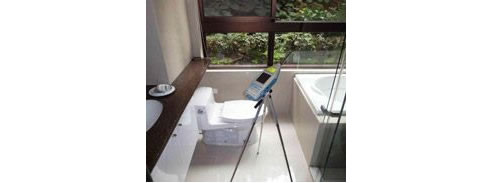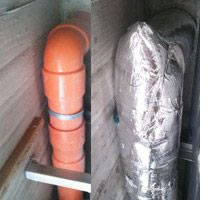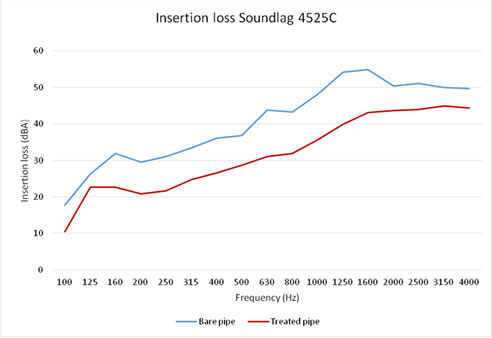Bathroom Noise Acoustic Solutions from Pyrotek Noise Control Beat Bathroom Noise
According to Owners Corporation Network Australia (2012): In an apartment, setting one of the most disturbing noise sources is from waste pipes coming from bathrooms. In a recent project, Pyrotek Noise Control was asked to provide a solution for a loud waste pipe in an apartment building. Measurements showed every time the toilet was flushed, the noise coming from the waste pipe was at nearly 61.0 dBA in the bathroom. Not only was this reading significantly higher than the recommended maximum level for bathroom noise of 55 dBA as defined by AS/NZ 2107: 2000 (pp. 11), it was the equivalent of an operating washing machine or a busy office. Measurements taken in the living area were only marginally quieter with a reading of 53 dBA, which still meant interrupted sleep once the bathroom was visited. This reading was also higher than the recommended maximum level for living area noise of 40-45 dBA as defined by AS/NZ 2107:200 (pp.11). The loud noise created by the flushing toilet lead to general disturbance for the apartment residents and those of adjoining apartments during the day. However, the main issue for apartment residents was interrupted sleep at night when the toilet unit was flushed. According to the Australian Government (2004, pp. 21) report on health impacts of environmental noise: "Noise affects people's ability to gain the appropriate amount and type of sleep needed for maintenance of good health and there are suggestions of disturbed sleep leading to more serious health problems." Furthermore, the report goes on to identify more specific impacts that noise and sleep deprivation can have on an individuals by stating: "Sleep loss reduces cognitive function and can affect physiology, behaviour and subjective outcomes. Statistically reductions occur in vigilance, memory, learning and speech." During its assessment of the problem, consultants, engaged by Pyrotek Noise Control, found a large unlagged waste pipe with an elbow bend to be the source of the loud noise.
After the installation of Soundlag, follow up tests in the bathroom showed a marked improvement with noise levels reduced by 8 dBA. Flushing noise in the bathroom now tested at a dramatically reduced 52 dBA; well down from the original 61 dBA, bringing the noise level down to that of a humming refrigerator. Living area noise levels had also decreased dramatically by the same amount to 44 dBA. Pyrotek's solution was able to bring noise levels in both the bathroom and living areas below the maximum level outlined by the Australian and New Zealand standards. The following graph shows the difference between the unlagged and lagged pipe with Soundlag 4525C.
After the installation of Soundlag providing the improved noise level readings, the apartment owner was very pleased with the results, stating that he was no longer sleep-deprived. The owner was also quick to commend Pyrotek on its prompt and smoothly run initial testing and problem diagnosis. Pipe lagging is a fundamental noise abatement technique. Highly desirable in private homes, it is fast becoming mandatory in high and medium-density residential complexes; especially where lighter construction materials leave rooms more vulnerable to noise intrusion. Guaranteed for ten years, Pyrotek's Soundlag product range is the most cost-effective way to solve pipe noise and meet building regulations. You simply cut, wrap and tape it to install. Appendix 1
Excerpt taken from AS/NZS 2107:2000 table 1 page 11
Reference List 2. Owners Corporation Network 2012, 'Noise in Strata Buildings' Owners Corporation Network, Retrieved 07/04/2014 http://ocn.org.au/book/export/html/1200 3. Standards Australia, 2000, 'Acoustics - Recommended design sound levels and reverberation times for building interiors', Standards Australia, Report, retrieved 07/04/2014
|
(02) 8868 2000 Girraween, NSW, 2145
|
|||||||||||




 Acoustic Plywood Panels for Yachts by
Acoustic Plywood Panels for Yachts by Noise Absorber for Tunnels by Pyrotek
Noise Absorber for Tunnels by Pyrotek Fyrewrap Marine Blanket by Pyrotek
Fyrewrap Marine Blanket by Pyrotek Litecore Marine Panel by Pyrotek
Litecore Marine Panel by Pyrotek Soundproofing for Pipes and Ducts by
Soundproofing for Pipes and Ducts by Industrial Noise Curtains by Pyrotek
Industrial Noise Curtains by Pyrotek Foil Faced Noise Barrier by Pyrotek
Foil Faced Noise Barrier by Pyrotek Marine Exhaust Systems by Pyrotek
Marine Exhaust Systems by Pyrotek Acoustic Lagging Solution for Cinemas by
Acoustic Lagging Solution for Cinemas by Mineral Wool Marine Insulation by
Mineral Wool Marine Insulation by Acoustic Absorbers for Outdoor
Acoustic Absorbers for Outdoor Vibration Damping Compound by Pyrotek
Vibration Damping Compound by Pyrotek Custom Removable Insulation Covers for
Custom Removable Insulation Covers for Flying Boats in Dubai | Pyrotek
Flying Boats in Dubai | Pyrotek Wavebar Roof in Classrooms by Pyrotek
Wavebar Roof in Classrooms by Pyrotek Removable Insulation Covers by Pyrotek
Removable Insulation Covers by Pyrotek Soundlag Acoustic Insulation for Cinemas
Soundlag Acoustic Insulation for Cinemas Australian-made Mass Loaded Vinyl Noise
Australian-made Mass Loaded Vinyl Noise Elevator Shaft or Chute Noise Control
Elevator Shaft or Chute Noise Control World-class Studio Soundproofing with
World-class Studio Soundproofing with
